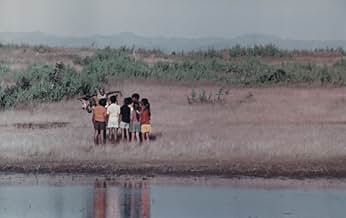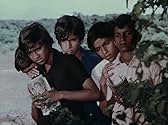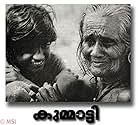Aggiungi una trama nella tua linguaA magician who entertains children temporarily transforms his young spectators of a village into animals. However, a boy transformed into a dog misses the moment to break the spell and has t... Leggi tuttoA magician who entertains children temporarily transforms his young spectators of a village into animals. However, a boy transformed into a dog misses the moment to break the spell and has to wait for the magician to return.A magician who entertains children temporarily transforms his young spectators of a village into animals. However, a boy transformed into a dog misses the moment to break the spell and has to wait for the magician to return.
- Regia
- Sceneggiatura
- Star
Recensioni in evidenza
I am angry at myself that I watched the version that was not the 2021 remaster that was presented by Scorsese and instead saw the one that is good quality but doesn't have the same colour correction and details as the newer one. I should have checked that first and for anyone trying to see this, make sure you're watching the correct version to not miss the full effect of the incredible cinematography of this movie.
This is such a sweet folktale that also works as a time capsule of central Kerala during that time. The surreal magical realism of the film works perfectly with minimal dialogue. But I did feel like it shouldn't even have any dialogue with the way most of the dialogue is written and delivered. However, it's the songs that complemented the visuals to make the movie really work. Karukare Karmukil is such an iconic folk song now. The dog was also an incredible actor. How they managed to make it work back then is a wonder.
This and Kanchana Sita, the two G Aravindan films I've seen have their similarities in a way, that both feel like low-budget films that focus more on visual storytelling with a bit of a fantasy narrative. Even though I like both, Kummatty is the superior one for me. Both films have themes that I understand and like, some themes that feel a bit forced, more so over in Kanchana Sita, and a lot of layers I feel I haven't understood fully. Maybe the more I see Aravindan films, the more I'd learn to love the style.
This is such a sweet folktale that also works as a time capsule of central Kerala during that time. The surreal magical realism of the film works perfectly with minimal dialogue. But I did feel like it shouldn't even have any dialogue with the way most of the dialogue is written and delivered. However, it's the songs that complemented the visuals to make the movie really work. Karukare Karmukil is such an iconic folk song now. The dog was also an incredible actor. How they managed to make it work back then is a wonder.
This and Kanchana Sita, the two G Aravindan films I've seen have their similarities in a way, that both feel like low-budget films that focus more on visual storytelling with a bit of a fantasy narrative. Even though I like both, Kummatty is the superior one for me. Both films have themes that I understand and like, some themes that feel a bit forced, more so over in Kanchana Sita, and a lot of layers I feel I haven't understood fully. Maybe the more I see Aravindan films, the more I'd learn to love the style.
What a lovely little film this turned out to be! Seeped in the rustic goodness of a Malayali village and the charmed music from God's own country, this mythical tale was a breath of fresh air. Dotted with songs that will have you humming along, the film follows a gang of children and their fate when an old man turns up in their village, and is labeled as Kummatty, or the Bogeyman.
The film stays honest to its setting - somehow managing to weave the peace and simplicity of the village into its characters, into its dialogue, and into its fluid song sequences. The relationship between the young and the old is beautifully captured, and when the film comes a full circle, Chinda, our main protagonist, realizes a thing or two about freedom and captivity.
This film may very well be India's own Pied Piper of Hamlin, and is a slice of folklore that is very unique to the country. Kummattikali is a dance form still practiced in Kerala during the Onam festival - and the legend seems to have arisen from the Mahabharata, where the Kummattis, or the ghost-companions of Lord Shiva, were called upon to dance and celebrate the virtue of Arjuna. And yes, masks have a huge role to play in this film, as they do in the dance form. A deliberate start but a great story in the end.
The film stays honest to its setting - somehow managing to weave the peace and simplicity of the village into its characters, into its dialogue, and into its fluid song sequences. The relationship between the young and the old is beautifully captured, and when the film comes a full circle, Chinda, our main protagonist, realizes a thing or two about freedom and captivity.
This film may very well be India's own Pied Piper of Hamlin, and is a slice of folklore that is very unique to the country. Kummattikali is a dance form still practiced in Kerala during the Onam festival - and the legend seems to have arisen from the Mahabharata, where the Kummattis, or the ghost-companions of Lord Shiva, were called upon to dance and celebrate the virtue of Arjuna. And yes, masks have a huge role to play in this film, as they do in the dance form. A deliberate start but a great story in the end.
From direction to the impeccable story telling, kummatty is a one of kind movie.
This is a Malayalam language children's film by G Aravindan.
The film is a visual treat. The beauty of traditional village life in Kerala is artistically captured. The film starts with a view of the rising sun. There are many scenes taken from vista points like hilltops while moving the scene forward. Definitely signs of a master creater with an eye for natural beauty.
The film is a fictional account of a village where a travelling bogeyman (Kummatty) visits. There are myths surrounding such people in villages saying they can convert naughty children to animals and take them away. These are just to ensure children are careful with strangers and also to spook them when they behave naughtily as it happens in this film too.
It's brilliant story writing to make a film with a good moral message around that. The film leaves us with a touching message to be compassionate towards birds and animals. It attempts that we empathize how caged pets would be feeling and the value of freedom.
The film story really starts only in the last half hour and the first hour is really a character sketch of village life when in blissful childhood.
The film is a visual treat. The beauty of traditional village life in Kerala is artistically captured. The film starts with a view of the rising sun. There are many scenes taken from vista points like hilltops while moving the scene forward. Definitely signs of a master creater with an eye for natural beauty.
The film is a fictional account of a village where a travelling bogeyman (Kummatty) visits. There are myths surrounding such people in villages saying they can convert naughty children to animals and take them away. These are just to ensure children are careful with strangers and also to spook them when they behave naughtily as it happens in this film too.
It's brilliant story writing to make a film with a good moral message around that. The film leaves us with a touching message to be compassionate towards birds and animals. It attempts that we empathize how caged pets would be feeling and the value of freedom.
The film story really starts only in the last half hour and the first hour is really a character sketch of village life when in blissful childhood.
Capturing the soul of a Malayali village movie tells the story is great depth.
I più visti
Accedi per valutare e creare un elenco di titoli salvati per ottenere consigli personalizzati
Dettagli
Contribuisci a questa pagina
Suggerisci una modifica o aggiungi i contenuti mancanti



















